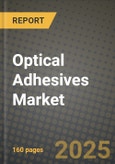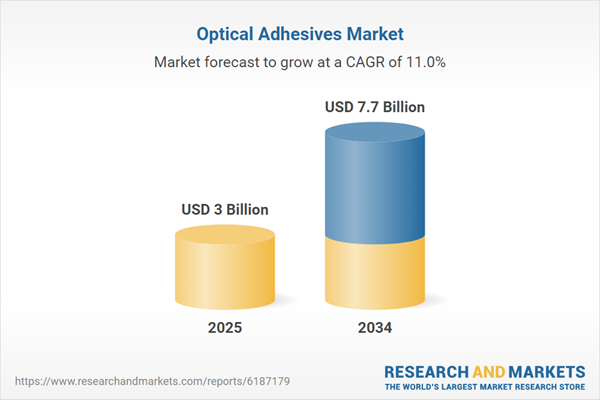The optical adhesives market is experiencing significant growth, driven by increasing demand in industries such as electronics, automotive, medical devices, and telecommunications. Optical adhesives are specialized bonding materials used for high-precision applications, ensuring superior light transmission, durability, and environmental resistance in optical components. These adhesives are widely used in the assembly of lenses, fiber optics, displays, sensors, and LED lighting systems, where optical clarity and minimal light distortion are crucial. Advancements in adhesive formulations, including UV-curable, epoxy-based, and silicone-based adhesives, have improved adhesion strength, temperature stability, and chemical resistance. With the rapid expansion of optoelectronics, high-resolution imaging, and augmented reality (AR) technologies, manufacturers are investing in high-performance optical adhesives that enhance product longevity and efficiency. Additionally, the growing trend toward miniaturization in consumer electronics and medical devices is fueling demand for precision bonding solutions, positioning optical adhesives as a critical component in next-generation optical and photonic applications.
The optical adhesives market witnessed notable advancements in high-refractive-index formulations, fast-curing technologies, and environmentally friendly adhesive solutions. The adoption of UV-curable adhesives surged due to their rapid curing times, improved optical clarity, and reduced energy consumption during the bonding process. Manufacturers focused on developing low-outgassing and low-shrinkage adhesives, catering to aerospace and semiconductor applications where precision bonding is critical. Additionally, the expansion of AR/VR (augmented reality/virtual reality) headsets, advanced automotive LiDAR systems, and next-generation smartphone cameras created new growth opportunities for optical adhesive manufacturers. The demand for biocompatible optical adhesives increased in the medical sector, particularly for endoscopic imaging, intraocular lenses, and wearable health-monitoring devices. Regulatory agencies emphasized sustainable adhesive formulations, encouraging the industry to invest in solvent-free, RoHS-compliant, and low-VOC (volatile organic compound) adhesives. As global supply chains stabilized, companies increased production capacity to meet the rising demand for high-performance optical bonding solutions across multiple industries.
The optical adhesives market is expected to be shaped by advancements in nanotechnology-based adhesives, AI-driven material optimization, and sustainable adhesive solutions. The development of nano-structured optical adhesives with enhanced light transmission, anti-reflective properties, and superior mechanical strength will drive innovation in high-precision optical assemblies. AI-powered predictive modeling will assist in formulating next-generation adhesives with customized properties, improving performance across various optical applications. The growing emphasis on sustainability will lead to increased adoption of bio-based and recyclable adhesives, minimizing environmental impact while maintaining high optical performance. The rise of quantum computing, photonics, and high-speed optical communication networks will further drive demand for low-loss optical adhesives that enable seamless integration of advanced optical components. Additionally, as display technologies evolve toward flexible and foldable screens, manufacturers will develop adaptive adhesives that maintain optical clarity and mechanical flexibility, supporting the next wave of innovation in consumer electronics and wearable technology.
Key Insights: Optical Adhesives Market
Advancements in UV-Curable Optical Adhesives: The adoption of UV-curable optical adhesives is growing due to their rapid curing times, high transparency, and superior adhesion properties. These adhesives provide excellent bonding strength while minimizing heat exposure, making them ideal for precision optical components. UV-curable adhesives are widely used in optical lens assembly, fiber optic connections, and display panels, ensuring minimal distortion and high durability. Manufacturers are focusing on enhancing UV-curable formulations to improve moisture resistance, thermal stability, and refractive index matching, expanding their applications across multiple high-tech industries.Emergence of Nano-Structured and Smart Optical Adhesives: Nanotechnology is playing a pivotal role in the evolution of optical adhesives, leading to the development of adhesives with enhanced refractive control, self-healing properties, and reduced light scattering. Nano-structured adhesives are enabling better performance in advanced imaging systems, high-speed optical networks, and AR/VR devices. Additionally, smart adhesives with adaptive optical properties are being explored for dynamic display technologies and next-generation optoelectronics. These innovations are paving the way for more efficient and resilient optical adhesive solutions, improving performance across a wide range of optical applications.
Growing Demand for High-Resolution Imaging and AR/VR Devices: The rising adoption of high-resolution cameras, AR/VR headsets, and LiDAR-based sensing systems is driving the demand for precision optical adhesives. These adhesives are essential for ensuring superior light transmission and minimal optical distortion in advanced imaging and sensor applications. As industries such as automotive, healthcare, and consumer electronics increasingly rely on high-performance optical technologies, the need for advanced optical adhesives with enhanced bonding strength, clarity, and durability continues to grow, fueling market expansion.
Expansion of 5G and Optical Communication Networks: The rapid deployment of 5G and high-speed optical communication networks is increasing the demand for low-loss optical adhesives used in fiber optics, waveguides, and photonic integrated circuits. Optical adhesives play a critical role in ensuring signal integrity, reducing transmission losses, and improving long-term reliability in high-speed data transmission systems. As data centers and telecom infrastructure continue to expand, manufacturers are focusing on developing thermally stable and high-performance optical adhesives that enhance network efficiency and optical connectivity.
Stringent Performance and Durability Requirements: Optical adhesives must meet stringent performance criteria, including high optical transparency, long-term stability, and resistance to environmental factors such as temperature fluctuations, humidity, and UV exposure. Developing adhesives that maintain optical performance over extended periods while withstanding harsh operating conditions remains a key challenge for manufacturers. Ensuring compatibility with emerging optical technologies and advanced photonic devices requires continuous research and innovation, increasing development costs and market entry barriers.
Optical Adhesives Market Segmentation
By Type
- Acrylic
- Silicone
- Epoxy
- Cyanoacrylate
- Other Types
By Application
- Optical Bonding and Assembly
- Lens Bonding Cement
- Fiber Optics
- Other Applications
By End-Use
- Electrical and Electronics
- Automotive
- Aerospace
- Other End-Uses
Key Companies Analysed
- Dow Inc.
- Saint-Gobain S.A.
- 3M Company
- Henkel AG & Co. KGAA
- Shin-Etsu Chemical Co.
- Ltd.
- SIKA AG
- DIC Corporation
- Nitto Denko Corporation
- H.B. Fuller Company
- Denka Company Limited
- Momentive Performance Materials Inc.
- Lintec Corporation
- Tesa SE
- Thorlabs Inc.
- LORD Corporation
- Nan Pao Resins Chemical Co. Ltd.
- Dexerials Corporation
- DELO Industrie Klebstoffe GmbH & Co. KGaA
- Dymax Corporation
- Epotek Inc.
- Parson Adhesives India Private Limited
- Showa Denko Corporation
- Panacol-Elosol GmbH
- Atom Adhesive LLC
- Hernon Manufacturing Inc.
- Muromachi Chemicals Inc.
- Permabond Engineering Adhesives Ltd.
- Master Bond Inc.
- Norland Products Inc.
- Mactac LLC
Optical Adhesives Market Analytics
The report employs rigorous tools, including Porter’s Five Forces, value chain mapping, and scenario-based modeling, to assess supply-demand dynamics. Cross-sector influences from parent, derived, and substitute markets are evaluated to identify risks and opportunities. Trade and pricing analytics provide an up-to-date view of international flows, including leading exporters, importers, and regional price trends.Macroeconomic indicators, policy frameworks such as carbon pricing and energy security strategies, and evolving consumer behavior are considered in forecasting scenarios. Recent deal flows, partnerships, and technology innovations are incorporated to assess their impact on future market performance.
Optical Adhesives Market Competitive Intelligence
The competitive landscape is mapped through proprietary frameworks, profiling leading companies with details on business models, product portfolios, financial performance, and strategic initiatives. Key developments such as mergers & acquisitions, technology collaborations, investment inflows, and regional expansions are analyzed for their competitive impact. The report also identifies emerging players and innovative startups contributing to market disruption.Regional insights highlight the most promising investment destinations, regulatory landscapes, and evolving partnerships across energy and industrial corridors.
Countries Covered
- North America - Optical Adhesives market data and outlook to 2034
- United States
- Canada
- Mexico
- Europe - Optical Adhesives market data and outlook to 2034
- Germany
- United Kingdom
- France
- Italy
- Spain
- BeNeLux
- Russia
- Sweden
- Asia-Pacific - Optical Adhesives market data and outlook to 2034
- China
- Japan
- India
- South Korea
- Australia
- Indonesia
- Malaysia
- Vietnam
- Middle East and Africa - Optical Adhesives market data and outlook to 2034
- Saudi Arabia
- South Africa
- Iran
- UAE
- Egypt
- South and Central America - Optical Adhesives market data and outlook to 2034
- Brazil
- Argentina
- Chile
- Peru
Research Methodology
This study combines primary inputs from industry experts across the Optical Adhesives value chain with secondary data from associations, government publications, trade databases, and company disclosures. Proprietary modeling techniques, including data triangulation, statistical correlation, and scenario planning, are applied to deliver reliable market sizing and forecasting.Key Questions Addressed
- What is the current and forecast market size of the Optical Adhesives industry at global, regional, and country levels?
- Which types, applications, and technologies present the highest growth potential?
- How are supply chains adapting to geopolitical and economic shocks?
- What role do policy frameworks, trade flows, and sustainability targets play in shaping demand?
- Who are the leading players, and how are their strategies evolving in the face of global uncertainty?
- Which regional “hotspots” and customer segments will outpace the market, and what go-to-market and partnership models best support entry and expansion?
- Where are the most investable opportunities - across technology roadmaps, sustainability-linked innovation, and M&A - and what is the best segment to invest over the next 3-5 years?
Your Key Takeaways from the Optical Adhesives Market Report
- Global Optical Adhesives market size and growth projections (CAGR), 2024-2034
- Impact of Russia-Ukraine, Israel-Palestine, and Hamas conflicts on Optical Adhesives trade, costs, and supply chains
- Optical Adhesives market size, share, and outlook across 5 regions and 27 countries, 2023-2034
- Optical Adhesives market size, CAGR, and market share of key products, applications, and end-user verticals, 2023-2034
- Short- and long-term Optical Adhesives market trends, drivers, restraints, and opportunities
- Porter’s Five Forces analysis, technological developments, and Optical Adhesives supply chain analysis
- Optical Adhesives trade analysis, Optical Adhesives market price analysis, and Optical Adhesives supply/demand dynamics
- Profiles of 5 leading companies - overview, key strategies, financials, and products
- Latest Optical Adhesives market news and developments
Additional Support
With the purchase of this report, you will receive:- An updated PDF report and an MS Excel data workbook containing all market tables and figures for easy analysis.
- 7-day post-sale analyst support for clarifications and in-scope supplementary data, ensuring the deliverable aligns precisely with your requirements.
- Complimentary report update to incorporate the latest available data and the impact of recent market developments.
This product will be delivered within 1-3 business days.
Table of Contents
Companies Mentioned
- Dow Inc.
- Saint-Gobain S.A.
- 3M Company
- Henkel AG & Co. KGAA
- Shin-Etsu Chemical Co. Ltd.
- SIKA AG
- DIC Corporation
- Nitto Denko Corporation
- H.B. Fuller Company
- Denka Company Limited
- Momentive Performance Materials Inc.
- Lintec Corporation
- Tesa SE
- Thorlabs Inc.
- LORD Corporation
- Nan Pao Resins Chemical Co. Ltd.
- Dexerials Corporation
- DELO Industrie Klebstoffe GmbH & Co. KGaA
- Dymax Corporation
- Epotek Inc.
- Parson Adhesives India Private Limited
- Showa Denko Corporation
- Panacol-Elosol GmbH
- Atom Adhesive LLC
- Hernon Manufacturing Inc.
- Muromachi Chemicals Inc.
- Permabond Engineering Adhesives Ltd.
- Master Bond Inc.
- Norland Products Inc.
- Mactac LLC
Table Information
| Report Attribute | Details |
|---|---|
| No. of Pages | 160 |
| Published | October 2025 |
| Forecast Period | 2025 - 2034 |
| Estimated Market Value ( USD | $ 3 Billion |
| Forecasted Market Value ( USD | $ 7.7 Billion |
| Compound Annual Growth Rate | 10.9% |
| Regions Covered | Global |
| No. of Companies Mentioned | 30 |









